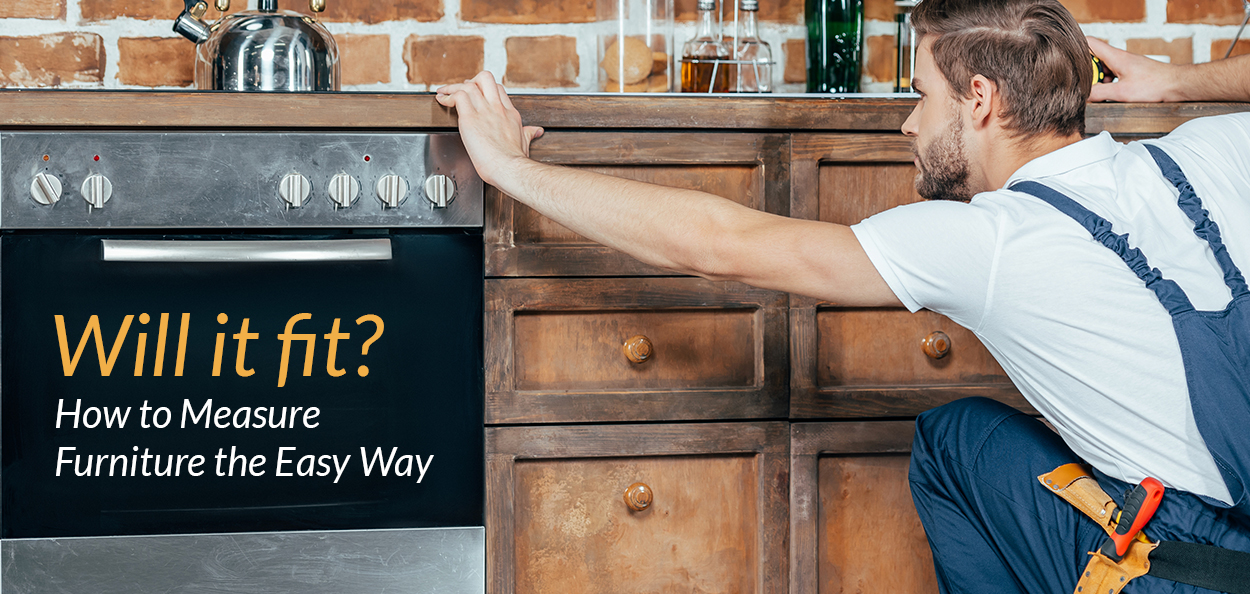Buying new furniture for your home is a great way to mix it up and stay up-to-date with interior design trends. Picking out your furniture is the first and arguably most exciting step, but don’t get your wallet out just yet. Measuring your furniture before you purchase is crucial if you want to find the perfect piece. Learn how to measure your furniture the easy way and make the most of your space with these furniture arrangement tips.
First off, measuring your furniture to guarantee it will fit requires more than a couple measurements. Let’s break the process into steps.
Step 1: Measure Your Space
Get an idea of the space you have to work with by measuring the room your furniture will be put in. This step is the easiest because all that you’re concerned with is the length and width of the room.

Step 2: Measure Entries, Passageways, and Stairwells
Now on to the most time consuming part. This step is absolutely crucial, but is often forgotten because people get caught up in simply measuring the room to see how to arrange the furniture. To ensure your furniture delivery goes smoothly, take the time to measure the height, width, and diagonal width of every doorway, hallway, elevator, and staircase you’ll be moving the furniture through. Don’t forget to make note of fixtures and architectural design because those can cause major obstacles! Here are some extra tips when measuring each area.
Doorways and Hallways
-
Consider handrails, doorknobs, trim, and hinges that can’t be removed and include those in your measurements.
-
Measure the entry clearance of all doors (the space between the door and the nearest wall or immovable object). Interior doors can be removed and reattached if needed.
Stairways
-
Start with the width of the stairway, then measure the width and depth of any landings.
-
Lastly, measure the ceiling height in three locations:
-
From the bottom step to the ceiling
-
If applicable, from landings to the ceiling
-
From the top step to the ceiling
-

Step 3: Measure Furniture
After that lengthy second step, break out that measuring tape again and measure the furniture pieces that you’re considering buying. Measure the length, width, and height, as well as the diagonal depth of sofas, chairs, and desks. For bookcases, entertainment centers, armoires, and other tall pieces of furniture, measure the diagonal height (from the bottom left corner to the top right corner).
Step 4: Compare Dimensions
As soon as you’re sick and tired of seeing measuring tapes and numbers, muster up your last ounce of energy to compare all of the dimensions you’ve recorded. Take all of the measurements from your space, entries, hallways, and stairways to see if they work with the furniture pieces. While you go through this step, determine whether the furniture will be able to fit through the space straight, at an angle, or on its end.

General Tips
If you follow these steps and understand how to measure your furniture accurately, you should have a solid foundation for deciding which furniture pieces will fit into your space. Before you make the final decision and get that credit card out, go through these general tips to be extra prepared:
-
Any furniture you buy should have clearance around it and be at least 4 inches less than the passage measurements.
-
During your measuring frenzy, remember to account for any obstacles (movable or immovable) that may cause issues when the furniture is being delivered. Light fixtures, wall art, and area rugs are some examples of obstacles you can easily move out of the way. Fire sprinklers, angled or low ceilings, and handrails aren’t going anywhere, so plan ahead for that!
-
While you record your measurements, keep them tidy and organized. Make sure they’re in an easily accessible spot so that you can reference them quickly!

Arrange Your Furniture Like a Pro
Now that you have your brand new, stylish furniture bought and delivered, you may be wondering where to place it in your home. Check out these tricks on how to design your living room to make the most out of your space:
-
Visualize the Flow. Take a walk through of your home and get a feel for how your guests will travel through each room. Make your entry path obvious and arrange your furniture in a way that makes transitioning from room to room effortless.
-
Create a Focal Point. Each room should have a focal point that draws people’s attention and centers the room. Consider what the space will be used for to make the decision a little easier. A seating arrangement or home entertainment section are just a couple examples of focal points.
-
Mix Up Sizing. To add depth and interest to a space, arrange your furniture in a way that mixes up sizes. For example, include a large sofa with small chairs and side tables.
-
Social Spaces. In a room meant for socializing, arrange your furniture away from the walls to create a cozy, intimate atmosphere. This can be a few feet or a few inches.
-
Tame Tall Rooms. Make large, tall rooms more comfortable and appealing by compensating with similar sized furnishings. Chairs with tall backs, big sofas, long vertical drapes, and long tables will help fill the space to make it more cozy.
With all of these tips and tricks, you’re now ready to bust out that wallet, buy your furniture pieces, and arrange them in your home with confidence. For other tips on how to freshen up your home’s interior design, learn how to make your home more energy-efficient in this blog post.


